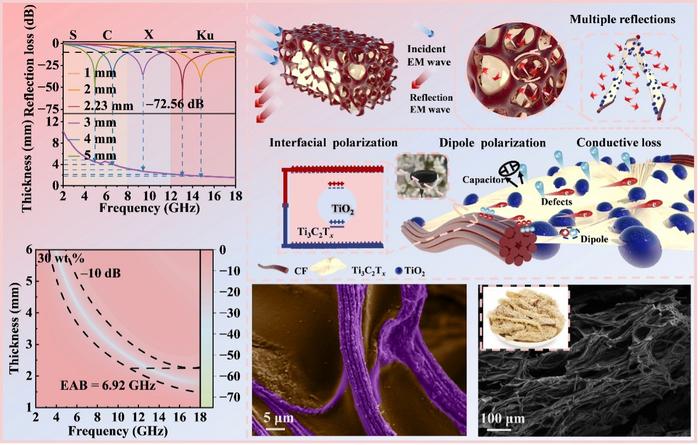
The advent of 5G technology and the relentless progression of electronic devices have raised pressing concerns regarding electromagnetic interference. This electromagnetic pollution not only jeopardizes technological systems but also poses significant risks to human health and national security. As society embraces this new wave of communication innovation, the demand for effective electromagnetic absorption materials has surged, emphasizing the necessity for solutions that fulfill criteria such as minimal thickness, lightweight design, broad absorption bandwidth, and superior reflection loss. A recent advance in this field has culminated in the development of a groundbreaking material distinguished for its remarkable microwave absorption capabilities.
The research team, spearheaded by Associate Professor Ying Li from Qingdao University of Technology, has unveiled a 3D N-doped carbon fiber/MXene/TiO2 nano-aerogel, a product born from careful engineering of its micro and macro structures. This innovative aerogel achieves exceptional electromagnetic wave absorption, recording a staggering minimum reflection loss of −72.56 dB. Achieving this level of efficiency at a thickness of only 2.23 mm, alongside an effective absorption bandwidth of 6.92 GHz, significantly elevates its performance beyond many existing materials in the telecommunications sector.
The project champions a dual perspective in material design—a micro-macro synergy that allows for the creation of multi-component and multi-dimensional structures. The novel approach taken by the researchers harnesses the principles of heterogeneous interface engineering to modify impedance matching and energy dissipation, establishing a new frontier in the synthesis of high-performance microwave absorbers. In addressing the intricate interactions at heterogeneous interfaces, this research taps into the Maxwell-Wagner effect to manipulate dielectric and magnetic properties, bridging the gap between macro-level applications and nano-scale phenomena.
Integral to the design of this nano-aerogel is the use of biomass cotton, which serves as a sustainable matrix offering a three-dimensional framework. The inclusion of green materials not only enhances the material’s ecological appeal but also alleviates the challenges associated with the self-stacking behavior of MXene, a two-dimensional material integral to achieving the desired performance metrics. Concurrently, the controlled in-situ generation of titanium dioxide (TiO2) contributes to the creation of diverse heterogeneous interfaces, bolstered further by nitrogen atom incorporation through polyimide carbonization. This strategic doping helps create lattice defects, which in turn enhance polarization losses, thereby optimizing microwave absorption.
The lightweight nature of the 3D N-CMT nano-aerogel, recorded at just 0.048 g/cm³, is another remarkable feature that sets it apart from traditional materials. This low density enhances its mechanical robustness and thermal stability, demonstrated by a loss rate of merely 13.7% at temperatures reaching 800 °C. Such thermal resilience, paired with excellent performance in microwave absorption, positions this material as a prime candidate for applications in radar stealth and other defense-related technologies.
In terms of the research outcomes, the collaborative effort involved contributions from multiple experts in the field. Collaborators included Chunlei Dong, Sijia Wang, Associate Professor Dongyi Lei, Associate Professor Yifei Cui, Professor Yanru Wang, and Professor Ran Li, all from the School of Civil Engineering at Qingdao University of Technology, along with Professor Binbin Yin from City University of Hong Kong. Their collaborative findings were recently published in the esteemed journal Nano Research, marking a significant addition to the body of literature surrounding electromagnetic absorption technologies.
Financial backing for this innovative research was provided by various institutions, including the Joint Funds of the National Natural Science Foundation of China, the Qingchuang Technology Project, among others, demonstrating a robust support structure for this pioneering work. The scientific community has begun to take notice of this promising development, which not only adds to the growing repository of microwave absorbers but also sets a new standard for future research endeavors in this area.
Looking ahead, the implications of this research extend beyond academic interest; they tap into real-world applications that could enhance national security and technological infrastructure. As 5G technology proliferates and drives increased reliance on wireless data transmission, the need for effective remediation of electromagnetic interference becomes critical. The employment of materials like the 3D N-CMT nano-aerogel is poised to play an essential role in protective measures across diverse fields, including military operations and civilian telecommunications.
In conclusion, the synthesis of N-doped carbon fiber/MXene/TiO2 nano-aerogel exemplifies not only a technical achievement but also a step toward a more sustainable and effective approach in electromagnetic wave management. By intertwining advanced material science with practical applications, this research marks a pivotal moment in addressing modern challenges associated with electromagnetic pollution, setting the stage for further innovations that marry performance with ecological responsibility.
Subject of Research: Development of a 3D N-doped carbon fiber/MXene/TiO2 nano-aerogel for improving electromagnetic wave absorption.
Article Title: Micro-macro regulating heterogeneous interface engineering in 3D N-doped carbon fiber/MXene/TiO2 nano-aerogel for boosting electromagnetic wave absorption.
News Publication Date: January 10, 2025.
Web References: Nano Research
References: None
Image Credits: Credit: Nano Research, Tsinghua University Press
Keywords
Electromagnetic absorption, Nano-aerogel, Microwave interruption, Material science, 5G technology, Environmental impact, Heterogeneous interfaces, Reflection loss, Impedance matching, National security, Defense applications, Sustainable materials.
Tags: 3D N-doped carbon fiber compositesadvanced materials for telecommunicationsdual perspective in material designeffective absorption bandwidth optimizationelectromagnetic wave absorption materialsemerging trends in electromagnetic pollution mitigationinnovative materials for 5G technologylightweight electromagnetic interference solutionsmicro-macro structure regulation in materials sciencemicrowave absorption capabilities in nanomaterialsMXene and TiO2 nano-aerogel engineeringreflection loss in electromagnetic materials





